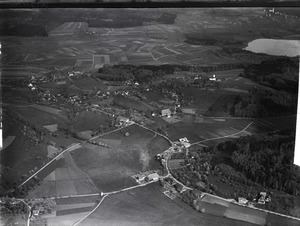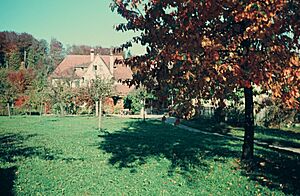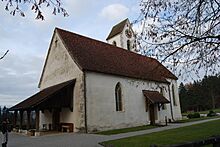Seeberg facts for kids
Quick facts for kids
Seeberg
|
||
|---|---|---|

Buildings and fountain in Seeberg village
|
||
|
||
| Country | Switzerland | |
| Canton | Bern | |
| District | Oberaargau | |
| Area | ||
| • Total | 16.8 km2 (6.5 sq mi) | |
| Elevation | 495 m (1,624 ft) | |
| Population
(Dec 2020 )
|
||
| • Total | 1,559 | |
| • Density | 92.80/km2 (240.3/sq mi) | |
| Postal code |
3365
|
|
| Surrounded by | Aeschi (SO), Alchenstorf, Heinrichswil-Winistorf (SO), Hellsau, Hermiswil, Oberönz, Ochlenberg, Steinhof (SO), Wynigen | |
Seeberg is a small town, also called a municipality, in Switzerland. It is located in the Oberaargau administrative district within the canton of Bern. A beautiful lake called Burgäschisee is found on its border with the nearby town of Aeschi. On January 1, 2016, another small town, Hermiswil, became part of Seeberg.
Contents
Seeberg's Past: A Look at History
Seeberg has a long history, with parts of it being mentioned in old records many centuries ago. Learning about its past helps us understand how it became the town it is today.
Hermiswil: Joining Seeberg
The village of Hermiswil was first written about in the year 1289. For a long time, in the 1200s and 1300s, the land around Hermiswil was given by the Kyburg family to another family called vom Stein.
Later, in 1466, the city of Solothurn took over all the lands that belonged to the vom Stein family, including Hermiswil. But after an agreement in 1665, Hermiswil was given to Bern. It was then managed by a local leader, called a Landvogt, from Wangen. Even though it was a small farming community, Hermiswil was located near important travel routes, including a road and a railway line built in 1857.
Oschwand: Home of a Famous Painter
Oschwand is a small part of Seeberg. A very famous painter named Cuno Amiet lived here for the second half of his life. He created many of his artworks while living in Oschwand and passed away there.
Seeberg's Land: What the Area Looks Like
Seeberg covers an area of about 15.8 square kilometers (about 6.1 square miles). A large part of this land, about 58.8%, is used for farming. Forests cover about 34% of the area. The remaining land is used for buildings and roads (6.5%) or is made up of rivers and other natural areas (0.7%).
Seeberg's People: Who Lives Here
Seeberg has a population of about 3,000 people. Most of the people living in Seeberg speak German (97.5%). A smaller number speak Turkish (0.7%) or French (0.5%).
Many adults in Seeberg (around 77.1%) have finished their education beyond basic schooling. This includes either advanced high school or higher education like university.
Seeberg has a very low unemployment rate, meaning most people who want to work have jobs. The town has different types of jobs:
- Primary sector: About 157 people work in farming and related businesses.
- Secondary sector: Around 77 people work in manufacturing and construction.
- Tertiary sector: About 138 people work in services, like shops, offices, and healthcare.
See also
 In Spanish: Seeberg para niños
In Spanish: Seeberg para niños







